This article lists ancient Roman aqueducts in the city of Rome.
Contents
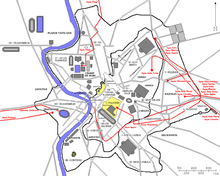

This article lists ancient Roman aqueducts in the city of Rome.


In order to meet the massive water needs of its huge population, the city of Rome was eventually supplied with 11 aqueducts by 226 AD, which were some of the city's greatest engineering achievements. Their combined capacity was capable of supplying at least 1,127,000 m3 (nearly 300 million gallons)[ citation needed ] of water to the city each day mostly from the Aniene river and the Apennine Mountains, serving a million citizens. Detailed statistics [1] for the city's aqueducts were logged around 97 AD by Sextus Julius Frontinus, the Curator Aquarum (superintendent of the aqueducts) for Rome during the reign of Nerva. Less information is known about aqueducts built after Frontinus.
These estimates may not have considered water loss. Modern engineers have questioned the validity of these figures and measured Anio Novus limestone deposits to estimate the average wetted perimeter and surface roughness corresponding to only 2/3 of the flow figure given below. [2]
| Name | Year begun | Year completed | Length (km) | Height at source (m) | Height in Rome (m) | Average gradient (%) | Capacity (m³ a day) [3] |
|---|---|---|---|---|---|---|---|
| Aqua Appia | 312 BC | 16.5 | 30 | 20 | 0.06 | 73,000 | |
| Aqua Anio Vetus | 272 BC | 269 BC | 64 | 280 | 48 | 0.36 | 176,000 |
| Aqua Marcia | 144 BC | 140 BC | 91 | 318 | 59 | 0.28 | 188,000 |
| Aqua Tepula | 125 BC | 18 | 151 | 61 | 0.51 | 18,000 | |
| Aqua Julia | 33 BC | 22 | 350 | 64 | 1.32 | 48,000 | |
| Aqua Virgo | 19 BC | 21 | 24 | 20 | 0.02 | 100,000 | |
| Aqua Alsietina | 2 BC | 33 | 209 | 17 | 0.59 | 16,000 (not drinkable) | |
| Aqua Anio Novus | 38 AD | 52 AD | 87 | 400 | 70 | 0.38 | 189,000 |
| Aqua Claudia | 38 AD | 52 AD | 69 | 320 | 67 | 0.37 | 184,000 |
| Aqua Traiana | 109 AD | 33 | - | - | - | ||
| Aqua Alexandrina | 226 AD | 22 | - | 50 | - | 120,000 to 320,000 | |
Sextus Julius Frontinus was a prominent Roman civil engineer, author, soldier and senator of the late 1st century AD. He was a successful general under Domitian, commanding forces in Roman Britain, and on the Rhine and Danube frontiers. A novus homo, he was consul three times. Frontinus ably discharged several important administrative duties for Nerva and Trajan. However, he is best known to the post-Classical world as an author of technical treatises, especially De aquaeductu, dealing with the aqueducts of Rome.
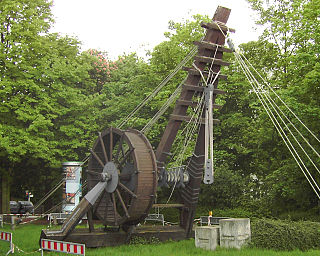
The ancient Romans were famous for their advanced engineering accomplishments. Technology for bringing running water into cities was developed in the east, but transformed by the Romans into a technology inconceivable in Greece. The architecture used in Rome was strongly influenced by Greek and Etruscan sources.

The Aqua Appia was the first Roman aqueduct, constructed in 312 BC by the co-censors Gaius Plautius Venox and Appius Claudius Caecus, the same Roman censor who also built the important Via Appia.
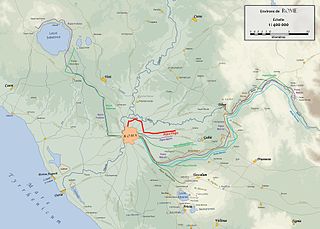
The Aqua Virgo was one of the eleven Roman aqueducts that supplied the city of ancient Rome. It was completed in 19 BC by Marcus Agrippa, during the reign of the emperor Augustus and was built mainly to supply the contemporaneous Baths of Agrippa in the Campus Martius.
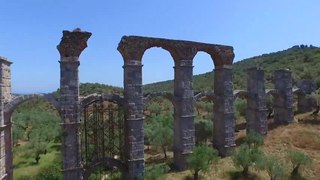
The Romans constructed aqueducts throughout their Republic and later Empire, to bring water from outside sources into cities and towns. Aqueduct water supplied public baths, latrines, fountains, and private households; it also supported mining operations, milling, farms, and gardens.

Aqua Anio Novus was an ancient Roman aqueduct supplying the city of Rome. Like the Aqua Claudia, it was begun by emperor Caligula in 38 AD and completed in 52 AD by Claudius, who dedicated them both on August 1.

Aqua Claudia was an ancient Roman aqueduct that, like the Aqua Anio Novus, was begun by Emperor Caligula in 38 AD and finished by Emperor Claudius in 52 AD.
Sanitation in ancient Rome, acquired from the Etruscans, was well advanced compared to other ancient cities and provided water supply and sanitation services to residents of Rome. Although there were many sewers, public latrines, baths and other sanitation infrastructure, disease was still rampant. The baths are known to symbolise the "great hygiene of Rome".

The Aqua Julia is a Roman aqueduct built in 33 BC by Agrippa under Augustus to supply the city of Rome. It was repaired and expanded by Augustus from 11–4 BC.
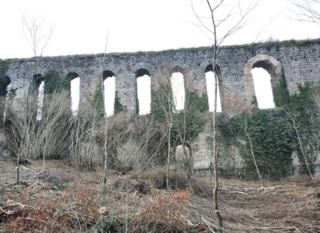
The Aqua Traiana was a 1st-century Roman aqueduct built by Emperor Trajan and inaugurated in 109 AD. It channelled water from sources around Lake Bracciano, 40 km (25 mi) north-west of Rome, to ancient Rome. It joined the earlier Aqua Alsietina to share a common lower route into Rome.

The Aqua Tepula is an ancient Roman aqueduct completed in 125 BC by censors Gnaeus Servilius Caepio, who had served as consul in 141 BC, and Lucius Cassius Longinus Ravilla.

In Ancient Rome, the Aqua Alsietina was the earlier of the two western Roman aqueducts, erected sometime around 2 BC, during the reign of emperor Augustus. It was the only water supply for the Transtiberine region, on the right bank of the river Tiber until the Aqua Traiana was built.
De aquaeductu is a two-book official report given to the emperor Nerva or Trajan on the state of the aqueducts of Rome, and was written by Sextus Julius Frontinus at the end of the 1st century AD. It is also known as De Aquis or De Aqueductibus Urbis Romae. It is the earliest official report of an investigation made by a distinguished citizen on Roman engineering works to have survived. Frontinus had been appointed Water Commissioner by the emperor Nerva in AD 96.

The Aqua Marcia is one of the longest of the eleven aqueducts that supplied the city of Rome. The aqueduct was built between 144–140 BC, during the Roman Republic. The still-functioning Acqua Felice from 1586 runs on long stretches along the route of the Aqua Marcia.
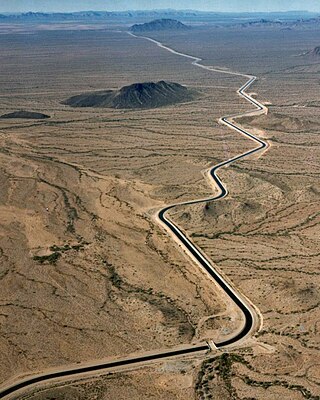
An aqueduct is a watercourse constructed to carry water from a source to a distribution point far away. In modern engineering, the term aqueduct is used for any system of pipes, ditches, canals, tunnels, and other structures used for this purpose. The term aqueduct also often refers specifically to a bridge carrying an artificial watercourse. Aqueducts were used in ancient Greece, ancient Egypt, and ancient Rome. The simplest aqueducts are small ditches cut into the earth. Much larger channels may be used in modern aqueducts. Aqueducts sometimes run for some or all of their path through tunnels constructed underground. Modern aqueducts may also use pipelines. Historically, agricultural societies have constructed aqueducts to irrigate crops and supply large cities with drinking water.
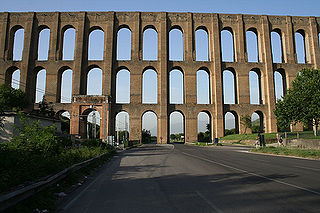
Aqueducts are bridges constructed to convey watercourses across gaps such as valleys or ravines. The term aqueduct may also be used to refer to the entire watercourse, as well as the bridge. Large navigable aqueducts are used as transport links for boats or ships. Aqueducts must span a crossing at the same level as the watercourses on each end. The word is derived from the Latin aqua ("water") and ducere, therefore meaning "to lead water". A modern version of an aqueduct is a pipeline bridge. They may take the form of tunnels, networks of surface channels and canals, covered clay pipes or monumental bridges.

Aqua Crabra was a Roman aqueduct supplying villas in the hinterland of the ancient town of Tusculum.

Quintus Marcius Rex was a Roman politician of the Marcii Reges, a patrician family of gens Marcia, who claimed royal descent from the Roman King Ancus Marcius. He was a paternal great-grandfather of Julius Caesar.

The Aqua Anio Vetus was an ancient Roman aqueduct, and the second oldest after the Aqua Appia.

The Curator Aquarum was a Roman official responsible for managing Rome's water supply and distributing free grain. Curators were appointed by the emperor. The first curator was Agrippa. Another notable Curator Aquarum was Frontinus, a Roman engineer.
![]() Media related to Ancient Roman aqueducts in Rome at Wikimedia Commons
Media related to Ancient Roman aqueducts in Rome at Wikimedia Commons